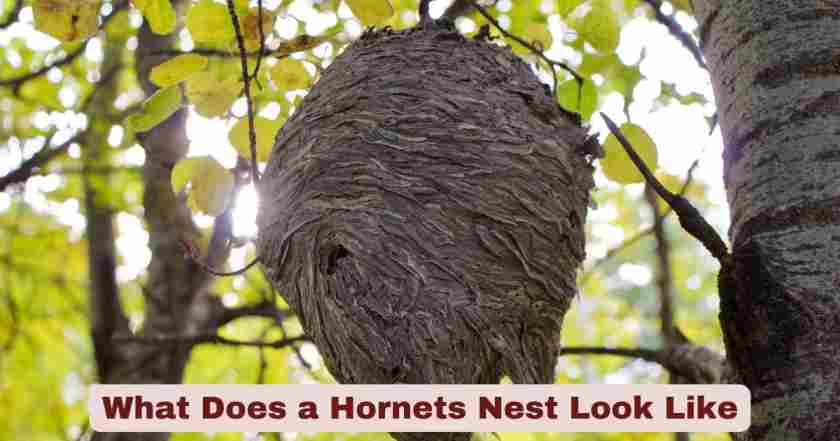If you’ve spotted a suspicious structure on your property, you’re probably wondering what does a hornets nest look like. This comprehensive guide will help you identify hornets nests quickly and safely, covering everything from physical appearance to seasonal changes and safety protocols.
What Does a Hornets Nest Look Like: Key Visual Characteristics
Hornets nests are among the most distinctive insect structures you’ll encounter. Understanding what does a hornets nest look like is crucial for homeowner safety and proper pest management decisions.
| Feature | Description | Identification Tips |
|---|---|---|
| Size | 12-24 inches diameter (mature) | Can exceed 3 feet in ideal conditions |
| Shape | Teardrop or football-shaped | Rounded top tapering to bottom |
| Color | Gray-brown with stripes | Natural wood fiber variations |
| Material | Paper-like texture | Made from chewed wood fibers |
| Location | 10-15 feet above ground | Protected areas, trees, eaves |
| Entrance | Single hole at bottom | Usually 1-2 inches diameter |
Detailed Physical Appearance of Hornets Nests
Exterior Construction and Texture
When examining what does a hornets nest look like, the exterior construction is the most noticeable feature. The outer envelope consists of multiple layers of paper-like material that hornets create through an intricate process. Worker hornets scrape wood fibers from various sources including weathered fences, tree bark, dead wood, and even cardboard or paper materials left outdoors.
| Construction Element | Source Material | Appearance | Function |
|---|---|---|---|
| Outer Envelope | Weathered wood fibers | Gray-brown, striped | Weather protection |
| Inner Layers | Fresh wood pulp | Lighter colored | Structural support |
| Entrance Tube | Reinforced pulp | Darker, thicker | Colony access |
| Repair Patches | Mixed fiber sources | Varied colors | Damage repair |
These wood fibers are thoroughly chewed and mixed with the hornet’s saliva, which contains enzymes that break down the cellulose. This creates a pulp-like substance that hornets spread in thin layers, allowing each layer to dry before adding the next. The result is a remarkably strong, water-resistant material that resembles aged parchment or weathered cardboard.
Size Variations Throughout the Season
Understanding what does a hornets nest look like requires knowledge of how these structures change size throughout their active season. The dramatic size progression from spring through fall is one of the most remarkable aspects of hornet nest development.
| Season | Size Range | Population | Activity Level | Nest Appearance |
|---|---|---|---|---|
| Early Spring | Golf ball to tennis ball | Queen only (1) | Low, nest building | Small, smooth exterior |
| Late Spring | Softball size | 10-50 workers | Moderate expansion | Visible layering begins |
| Early Summer | Basketball size | 100-200 workers | High construction | Multiple envelope layers |
| Mid Summer | Large basketball | 300-500 workers | Peak building | Complex entrance system |
| Late Summer | 2-3 feet diameter | 500-1000+ workers | Maximum activity | Weathered, patched exterior |
| Fall | Maximum size | Declining population | Aggressive defense | Signs of wear and damage |
During early spring, hornets nests start as small structures no larger than a golf ball. The founding queen works alone, creating the initial cells and outer envelope. As worker hornets emerge in late spring and early summer, the nest undergoes rapid expansion, often doubling in size every few weeks during peak building season.
Common Hornets Nest Locations and Placement
Aerial Nesting Sites
Most hornet species prefer elevated locations that provide protection from ground predators while offering easy access for foraging flights. Understanding what does a hornets nest look like in various locations helps homeowners identify potential problems early.
| Location Type | Specific Placement | Advantages for Hornets | Risk Level | Detection Difficulty |
|---|---|---|---|---|
| Tree Branches | Fork of major limbs | Natural camouflage, stability | Low | Easy to spot when leaves fall |
| Building Eaves | Under roof overhangs | Weather protection | High | Often visible from ground |
| Porch Ceilings | Covered outdoor areas | Human traffic deterrent | Very High | Easily overlooked until large |
| Shed Roofs | Protected corners | Minimal disturbance | Medium | May be hidden by vegetation |
| Fence Posts | Top of wooden posts | Open flight paths | Medium | Visible but often ignored |
| Deck Overhangs | Underneath structures | Protection + height | High | Dangerous proximity to humans |
Tree branches remain the most common natural nesting site. Hornets typically select the fork where multiple branches meet, providing excellent structural support. Deciduous trees are preferred over evergreens because they offer better branch architecture and the hornets can more easily attach their nest to multiple support points.
Ground and Cavity Nesting
While most people associate hornets with aerial nests, some species, particularly European hornets, may establish colonies in ground locations or existing cavities. These nest sites present unique identification challenges.
| Cavity Type | Common Locations | Nest Visibility | Access Points | Identification Signs |
|---|---|---|---|---|
| Hollow Trees | Dead or dying trees | Completely hidden | Natural openings | Heavy traffic at holes |
| Wall Voids | Building cavities | Internal growth | Entry gaps | Sounds inside walls |
| Underground | Abandoned burrows | Surface entrance only | Ground holes | Hornets entering/exiting soil |
| Attic Spaces | Building interiors | Partial visibility | Roof gaps | Interior nest construction |
| Crawl Spaces | Under buildings | Hidden construction | Foundation openings | Unusual insect activity |
These cavity nests can grow extremely large because they’re protected from weather and predators. European hornets may establish colonies that contain several thousand individuals in large tree cavities or wall voids.
Hornets Nest Development Stages and Timeline
Spring Emergence and Initial Construction
The hornets nest development cycle begins in early spring when fertilized queens emerge from winter hibernation. Understanding what does a hornets nest look like during each development stage helps homeowners identify problems before they become serious.
| Development Stage | Timeframe | Queen Activity | Nest Size | Worker Population | Nest Features |
|---|---|---|---|---|---|
| Site Selection | March-April | Location scouting | None | 0 | Queen inspects potential sites |
| Foundation | April-May | Initial construction | 2-4 inches | 0 | First cells and outer envelope |
| First Brood | May-June | Egg laying/care | 4-8 inches | 0 | Visible hexagonal cells |
| Worker Emergence | June-July | Reduced building | 8-12 inches | 10-50 | Multiple envelope layers |
| Rapid Expansion | July-August | Egg laying focus | 12-24 inches | 100-500 | Complex entrance system |
| Peak Population | August-September | Maximum egg production | 2-3 feet | 500-1000+ | Multiple entrance/exit points |
During the foundation stage, queens select sites based on specific criteria including protection from weather, proximity to food sources, and defensibility. The initial nest structure consists of a small cluster of hexagonal cells surrounded by the beginning of the protective envelope.
Mid-Season Growth and Expansion
As worker hornets emerge, they assume all construction and maintenance duties while the queen focuses exclusively on egg production. This division of labor leads to exponential nest growth during the mid-season period.
| Growth Phase | Duration | Size Increase | Construction Activity | Population Growth | Behavioral Changes |
|---|---|---|---|---|---|
| Early Expansion | 2-3 weeks | 50-100% increase | Envelope extension | Doubled weekly | Increased foraging |
| Rapid Growth | 4-6 weeks | 200-300% increase | Multiple layer addition | Tripled weekly | Territory establishment |
| Peak Building | 3-4 weeks | 100-150% increase | Interior reorganization | Gradual increase | Aggressive defense |
| Stabilization | 2-3 weeks | 25-50% increase | Maintenance focus | Population plateau | Maximum activity |
During rapid growth phases, worker hornets may add several inches to the nest diameter each week. The construction process involves continuous expansion of the outer envelope while simultaneously adding interior combs to accommodate the growing population.
Species-Specific Nest Characteristics
European Hornets Nest Features
European hornets, the largest hornets in North America, create distinctive nests that differ from other species. Knowing what does a hornets nest look like for this specific species helps in accurate identification.
| Characteristic | European Hornets | Other Hornet Species | Identification Value | Safety Implications |
|---|---|---|---|---|
| Size | Often exceeds 3 feet | Usually under 2 feet | High | Larger colonies more dangerous |
| Location Preference | Tree cavities, wall voids | Aerial, exposed locations | Very High | Hidden nests harder to detect |
| Entrance Design | Multiple small openings | Single large entrance | High | Multiple escape routes |
| Activity Period | Active at night | Daytime activity only | Very High | Night encounters possible |
| Color Pattern | Brown and yellow stripes | Black and white patterns | Medium | Species-specific behavior |
| Nest Material | Reddish-brown paper | Gray-brown paper | Medium | Indicates wood source variety |
European hornets often construct their nests inside tree cavities, making them less visible but potentially more dangerous due to their hidden nature. These nests can house over 1,000 individuals and remain active well into late fall.
Bald-Faced Hornets Nest Identification
Despite their name, bald-faced hornets are actually large yellowjackets, but their nests closely resemble true hornet nests. Understanding what does a hornets nest look like when built by this species prevents misidentification.
| Feature | Bald-Faced Hornets | True Hornets | Visual Differences | Behavioral Differences |
|---|---|---|---|---|
| Shape | Perfect football shape | Teardrop or irregular | More symmetrical | Similar construction pattern |
| Size | 12-18 inches typical | 18-36 inches possible | Generally smaller | Comparable population size |
| Entrance | Single bottom hole | Single or multiple | Similar design | Identical traffic patterns |
| Color | Gray with brown tones | Gray-brown uniform | Subtle variations | Similar defensive behavior |
| Location | Prefers trees | Trees and buildings | Habitat overlap | Comparable site selection |
| Season | Dies after first frost | Dies after first frost | Identical lifecycle | Same seasonal patterns |
Bald-faced hornets build some of the most architecturally perfect nests, with smooth, symmetrical exteriors and precisely positioned entrance holes. These nests are often mistaken for true hornet nests due to their similar construction methods.
Safety Considerations and Risk Assessment
Identifying Active vs. Abandoned Nests
Determining whether you’re looking at an active or abandoned nest is crucial for safety planning. Understanding what does a hornets nest look like when active versus inactive helps homeowners make informed decisions about removal or tolerance.
| Nest Status | Visual Indicators | Activity Signs | Time of Year | Safety Level | Action Required |
|---|---|---|---|---|---|
| Active – Early Season | Fresh, clean appearance | Moderate traffic | Spring-Summer | High Risk | Professional assessment |
| Active – Peak Season | Well-maintained exterior | Heavy traffic | Mid-Late Summer | Extreme Risk | Immediate professional help |
| Active – Late Season | Some wear, patches | Aggressive behavior | Fall | Very High Risk | Emergency response |
| Recently Abandoned | Good condition, no activity | No insect movement | Late Fall | Low Risk | Safe observation possible |
| Long Abandoned | Deteriorating, holes | No activity | Winter-Spring | Minimal Risk | Safe removal possible |
| Damaged Active | Holes, repairs visible | Defensive behavior | Any season | Extreme Risk | Emergency evacuation |
Active nests show constant hornet traffic, especially during daylight hours when worker hornets are foraging. The entrance hole remains clear and well-maintained, with hornets regularly entering and exiting in organized patterns.
Distance and Approach Guidelines
Establishing safe observation distances is essential when trying to determine what does a hornets nest look like without triggering defensive responses from the colony.
| Observation Purpose | Minimum Distance | Recommended Equipment | Safety Precautions | Time of Day | Weather Conditions |
|---|---|---|---|---|---|
| Initial Identification | 50+ feet | Binoculars | No sudden movements | Early morning | Calm, no wind |
| Size Assessment | 30-40 feet | Telephoto camera | Quiet approach | Late afternoon | Overcast preferred |
| Activity Monitoring | 25-30 feet | Timer, notepad | Escape route planned | Mid-morning | Stable conditions |
| Professional Documentation | 20-25 feet | Professional equipment | Full protective gear | Any time | Professional assessment |
| Emergency Situations | 100+ feet | Emergency communication | Immediate evacuation | Any time | Any conditions |
Professional pest control experts recommend never approaching closer than 20 feet to an active hornets nest without proper protective equipment. Hornets can detect vibrations and threatening movements from considerable distances.
Seasonal Changes in Nest Appearance
Monthly Development Timeline
Understanding what does a hornets nest look like throughout the entire season helps homeowners recognize problems early and plan appropriate responses.
| Month | Nest Development | Size Range | Population | Activity Level | Appearance Changes |
|---|---|---|---|---|---|
| March | Queen emergence only | No nest | 1 queen | Minimal | Site selection phase |
| April | Initial construction | 2-4 inches | 1 queen | Low building | Small gray bump |
| May | Foundation complete | 4-8 inches | 1 queen + eggs | Moderate | Visible structure |
| June | First workers emerge | 8-12 inches | 10-50 workers | Increasing | Rapid expansion begins |
| July | Major expansion | 12-18 inches | 100-300 workers | High | Multiple envelope layers |
| August | Peak construction | 18-24 inches | 300-700 workers | Maximum | Complex surface patterns |
| September | Maximum size | 24-36 inches | 500-1000+ workers | Peak aggression | Weather damage visible |
| October | Decline begins | Maximum reached | Declining | Defensive behavior | Patched, worn exterior |
| November | Colony death | Abandoned | 0 (after frost) | None | Deterioration starts |
The most dramatic changes occur between June and August when worker populations explode and nest construction accelerates. This period requires the most vigilance from homeowners.
Weather Impact on Nest Appearance
Environmental conditions significantly affect how hornets nests develop and what does a hornets nest look like after exposure to various weather patterns.
| Weather Condition | Impact on Nest | Appearance Changes | Hornet Response | Timing | Homeowner Implications |
|---|---|---|---|---|---|
| Heavy Rain | Water damage to exterior | Darker, soggy patches | Increased rebuilding | Any season | Weakened structure |
| High Winds | Physical damage | Tears, holes in envelope | Emergency repairs | Storm seasons | Potential nest failure |
| Extreme Heat | Drying and cracking | Brittle, faded surface | Increased water collection | Summer | More aggressive foraging |
| Cold Snaps | Reduced activity | No visible changes | Clustering behavior | Early/Late season | Temporary safety increase |
| Drought | Construction delays | Smaller than normal | Increased wood gathering | Summer | Extended building season |
| Humidity | Enhanced construction | Smooth, well-formed | Optimal building conditions | Varies | Rapid nest growth |
Severe weather can damage hornets nests, leading to emergency repair activities that increase hornet aggression and territorial behavior around the nest site.
Professional vs. DIY Identification and Management
When Professional Assessment is Required
Determining what does a hornets nest look like often requires expert evaluation, especially in complex or dangerous situations.
| Situation | Professional Required | DIY Possible | Risk Level | Cost Implications | Time Sensitivity |
|---|---|---|---|---|---|
| Large Nests (24+ inches) | Yes | No | Extreme | High service cost | Immediate |
| Multiple Nests | Yes | No | Extreme | Very high cost | Immediate |
| Hidden/Cavity Nests | Yes | Limited | Very High | Moderate to high | Urgent |
| Near High-Traffic Areas | Yes | No | Extreme | High but necessary | Immediate |
| Aggressive Behavior | Yes | No | Extreme | High | Emergency |
| Small Spring Nests | Recommended | Possible | Moderate | Lower cost | Semi-urgent |
| Abandoned Nests | No | Yes | Low | Minimal | Low |
Professional pest control experts have specialized equipment, protective gear, and experience necessary for safe hornet nest management. They can also provide species identification and prevention recommendations.
Documentation and Monitoring Strategies
Proper documentation helps professionals understand what does a hornets nest look like in your specific situation and develop appropriate treatment strategies.
| Documentation Type | Information Needed | Recording Method | Frequency | Safety Distance | Professional Value |
|---|---|---|---|---|---|
| Location Photos | Nest position, surroundings | Digital camera, telephoto | One-time | 50+ feet | High |
| Size Measurements | Diameter, height estimates | Visual estimation | Weekly | 30+ feet | High |
| Activity Logs | Traffic patterns, timing | Written observations | Daily | 25+ feet | Very High |
| Behavior Notes | Aggression, defensive actions | Detailed descriptions | As observed | Safe distance | High |
| Growth Tracking | Size changes over time | Photo comparison | Bi-weekly | 40+ feet | Medium |
| Weather Correlations | Conditions vs. activity | Combined logs | Daily | Any distance | Medium |
Comprehensive documentation provides pest control professionals with essential information for developing safe, effective removal strategies while minimizing risk to homeowners and their families.
Conclusion
Understanding what does a hornets nest look like is essential for homeowner safety and effective pest management. These distinctive gray-brown, teardrop-shaped structures with their paper-like exterior and single entrance hole are unmistakable once you know what to look for. Remember that hornets nests vary significantly in size throughout the season, starting as small as golf balls in spring and potentially reaching three feet in diameter by fall.
The key to successful hornet nest identification lies in observing from safe distances, documenting nest characteristics, and recognizing the difference between active and abandoned colonies. Always prioritize safety over curiosity, and don’t hesitate to contact professional pest control services when dealing with large nests, aggressive hornets, or nests in high-traffic areas.
By understanding the seasonal development patterns, species-specific characteristics, and safety considerations outlined in this guide, homeowners can make informed decisions about hornets nests on their property while protecting their families and maintaining a safe outdoor environment.







